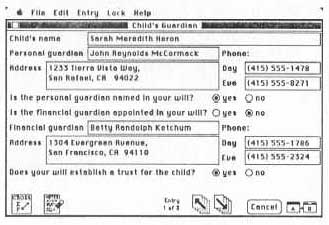FOR THE RECORD
Face it, our lives are filled with clutter. Consider for a moment the number and types of critical items each of us is required to remember or keep track of on a regular basis: birthdays, anniversaries, emergency telephone numbers, tax records, insurance policies, loan repayment schedules, automated-teller access codes, automobile registrations, Social Security numbers. The list goes on, and on, and on, ad nauseum. Think about it too long and the sheer bulk of data and details associated with this so-called Information Age threatens to overwhelm you.
Before surrendering your sanity, however, you should know that help is available. For the Record, from Nolo Press, is a nifty, inexpensive book-and-software package designed lo help you manage all the minutiae associated with life in the late twentieth century.
At the heart of For the Record is the program's preprogrammed database. You use this database to record and track information in 27 major categories, ranging from Business Interests to— I'm not kidding here— Death Plans. For the Record further divides each major category into 1-18 subcategories. Category 24, Personal Information, for example, includes subcategories for Employment History, Military Record, Past Residence and Marriage, among others. In a true tip of the hat to our modern culture, there's even a subcategory called Significant Relationship, in which you can record important dates and other items relating lo a nonmarital, live-in liaison.
All data entry occurs at this subcategory level. Here, you actually create a record by entering information into predefined data fields. The information requested is specific to each subcategory. In the Military Record subcategory, for example, you enter such information as Branch, Service Number, Date Entered, Date Discharged, Rank Achieved, Commendations, and so on. You can create an unlimited number of records for each subcategory. Although all fields are predefined, For the Record is fairly comprehensive in the types of information requested in its subcategories. Should you feel the need to expand on a given item, there's a Notes feature that lets you attach up to a full screen of text to individual records.
A recurring theme in virtually every subcategory is the Location of Documents field. This field symbolizes the overriding rationale behind this program. When used properly, For the Record lets you create and maintain an index (for want of a better metaphor) to the various items and information that, taken together, comprise your life. If, for example, I needed to quickly find my son's birth certificate, a quick look under the Your Family category would reveal that the document is stored in our safe deposit box at the local bank.

After records are entered, it's a simple matter to generate a printout of the information. You can choose to print a single record, all records in a specified category or subcategory, or the complete contents of a database. (Be warned, however, that this last option can literally take hours if your recordkeeping is anywhere near comprehensive.) Any notes attached to a record arc included with that record during a print operation.
For the Record is totally menu-driven. Selecting a category from the program's Main Menu displays a second menu, listing any subcategories associated with that item. If the subcategory for which you are entering data contains information that might be related to other subcategories, the program displays an <XREF> message at the bottom of the screen. A single keystroke calls up a listing of these ancillary subcategories. If you're unsure of a specific operation, online help is available. Though not context-sensitive, the program's help messages are comprehensive and well organized.
For the Record supports multiple databases. You might, for example, create a second database for those business-related items you wish to isolate from your personal records. To work with a file other than the default database, you simply include that file's name on the command line when you load the program. For added security, you can even assign password protection to individual categories within a database.
Unfortunately, all is not perfect with this program. For the Record's manual is loaded with useful information on both program operations and a wide range of topics relating lo the items recorded in your databases—information management, investment advice, financial issues, and, in some cases, legal considerations. Unfortunately, the writers place most of the responsibility for tracking down that information squarely on the user's shoulders. The manual's table of contents doesn't include page numbers, a major oversight. Even more unforgivable, its index is nothing more than a listing of subcategory headings, cross-referenced to the category (Main Menu item) under which they appear in the program.
My only other major complaint with the program is its lack of printer support. The MS-DOS version demands an Epson, an IBM-graphics, or a compatible printer. The Macintosh version works only with an Image-writer. LaserWriter, or compatible printer. Luckily, my Okidata Laser-line 6 can emulate an IBM graphics printer, or I'd have been out of luck.
Despite these two complaints, I like For the Record. It has superimposed some welcome structure on my previously chaotic record keeping habits. Sure, a traditional database program could accomplish the same thing while allowing for greater customization. But why should you invest the time, energy, and programming skills required to accomplish this? The good folks at Nolo have already done that work for you, anticipating 95 percent of your needs in the process.
JACK NIMERSHEIM
|
IBM PC and compatibles with DOS 3.0 or later and a graphics printer—$49.95 Macintosh with System Software 6.0 or later—$49.95 NOLO PRESS 950 Parker St. Berkeley, CA 94710 (415)549-1976 |